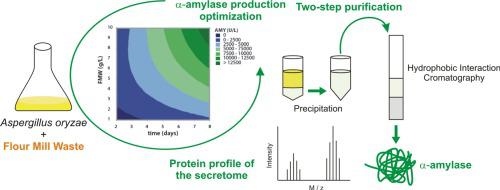Process Biochemistry ( IF 4.4 ) Pub Date : 2021-07-26 , DOI: 10.1016/j.procbio.2021.07.019 Mauricio Braia 1, 2 , Ignacio Cabezudo 3 , Virginia Lis Barrera 1 , Pablo Anselmi 1 , María-Rocío Meini 1 , Diana Romanini 1

|
Alpha-amylase is one of the most employed enzymes in the food industry because of its capacity to degrade starch, improving the organoleptic and nutritional properties of food products. Thus, it is very important to develop novel industrial production processes for its production. A submerged fermentation process using Aspergillus oryzae was optimised to modulate the most important factors affecting alpha-amylase production. Flour mill waste, an abundant worldwide agro-industrial residue, was used as substrate due to its starch-rich composition. This residue was able to avoid catabolite repression during the fermentation, acting as a slow-release substrate. The process optimization led to a maximum yield of alpha-amylase production of 14076 ± 2346 U/L. The secretome of the fungi in the tested conditions was analysed by LC-MS, showing that two isoforms of alpha-amylase (amy-1 and amy-3) were produced. Finally, a two-step process was developed to purify alpha-amylase, consisting of fractional precipitation using (NH4)2SO4 followed by hydrophobic interaction chromatography. The purification allowed a four-time concentration of alpha-amylase, with an eleven-time purification factor and 65 % recovery and a reduction of the proteolytic activity to 14%.
中文翻译:

米曲霉将面粉厂废料生物转化为α-淀粉酶的优化方法
α-淀粉酶是食品工业中最常用的酶之一,因为它能够降解淀粉,改善食品的感官和营养特性。因此,开发用于其生产的新型工业生产工艺非常重要。使用米曲霉的深层发酵工艺优化以调节影响α-淀粉酶产生的最重要因素。面粉厂废料是一种丰富的全球农业工业残留物,因其富含淀粉的成分而被用作基质。这种残留物能够避免发酵过程中的分解代谢物抑制,充当缓释底物。工艺优化导致 α-淀粉酶的最大产量为 14076 ± 2346 U/L。通过 LC-MS 分析了测试条件下真菌的分泌组,表明产生了两种 α-淀粉酶同种型(amy-1 和 amy-3)。最后,开发了一种两步法来纯化 α-淀粉酶,包括使用 (NH 4 ) 2 SO 4进行分级沉淀然后是疏水相互作用色谱。纯化允许 α-淀粉酶的四倍浓度,具有 11 倍的纯化因子和 65% 的回收率以及蛋白水解活性降低至 14%。



























 京公网安备 11010802027423号
京公网安备 11010802027423号